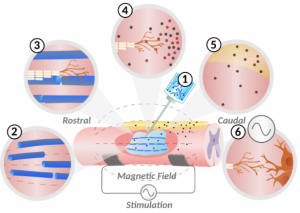Introduction
Yearly, there are between 250,000 to 500,000 people who suffer a spinal cord injury (SCI) worldwide. In Canada, an SCI will cost on average $1.5 to 3 million per person over their lifetime. Also, people with SCIs are 2 to 5 times more likely to die earlier than a person without an SCI. The significant amount of SCIs and the cost associated with this traumatic event has researchers eager to find a cure, but there has not been a successful solution so far. However, UBC researchers think they may have found a potential solution.
What is The Spinal Cord?
The spinal cord is a column of nerves that runs down the middle of your back. It functions to carry sensory information from your body to your brain, motor signals from your brain to your body and controls an individual’s reflex responses. The spinal cord is an essential part of the human body and allows us to sense and interact with our surrounding environment. Therefore, it can have profound implications when the spinal cord gets damaged.
Cause of Spinal Cord Injuries
The most common cause for SCIs is from trauma to the back: motor vehicle accidents for younger individuals and falls for those over 65 in the USA. Over 50% of spinal cord injuries occur in individuals between the ages of 16-30 years, with most being males.

Statistics associated with SCIs show the significance of this injury to society.
Source: https://mendthegap.ubc.ca/approach/
EXCITING NEW UBC RESEARCH
UBC researchers just received a $24 million grant for their “Mend the Gap” project working on spinal cord regeneration. The UBC scientist Dr. John Madden leads this project and works with engineers and researchers from Canada, the United States, Europe and Australia. The projects have 32 researchers from many disciplines, including electrical engineers, material chemists, microbiologists, neurobiologists, and neurosurgeons. Dr. Madden and his team hope to have the project completed in seven years.
UBC’s Mend the Gap teams unimaginable breakthrough in the world of SCI research. Source: Project Video By UBC Applied Science
The team’s research aims to use a soft gel containing small magnetic pieces that will help guide and reconnect the nerves damaged in the spinal cord. “Mend the Gap” has had success doing this in an artificial environment and is now working toward how this concept can be applied to the human body. The soft gel can modify itself to perfectly fit different shapes and sizes of gaps within the spinal cord in a non-invasive way. Furthermore, the gel contains medication that could help reduce scar tissue and help speed up the regeneration process.

The research method has complex procedural steps that rely on the use of a magnetic field. Source: https://mendthegap.ubc.ca/approach/
Importance of the Research
There are many people with SCIs globally; thus, they have a higher risk of mortality, demonstrating just how important this potentially life-saving research is and the impact it can have. Ultimately, this research has vast potential for impacting the lives of those with SCIs and provides hope for the future of spinal cord injury research.
